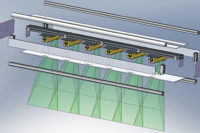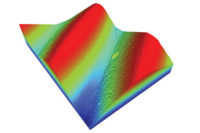
The vision system at NP Plastics uses two cameras to produce 3-D images of parts. Source: Allied Vision Technologies Inc.
Even for small mass-produced parts, it is worthwhile to use industrial image-processing systems to guarantee first-class quality. At NP Plastics (Noordwijkerhout, Netherlands), small plastic rollers for document binders are checked at a rate of 600 per minute in 3-D.
Document binders are a common sight in almost every office. The lever mechanics of such binders ensure that full, closed binders are solid, stable and easy to open and close. To ensure operating quality, the small plastic rollers in the closing mechanism are inspected with image-processing technology, guaranteeing that the binders will stand up to the strain of daily use.
To NP Plastics, a manufacturer of injection-molded plastic parts, the perfect quality of the small white rollers was worth the investment in an image-processing system. The challenge was to check the geometry of the approximately 5-millimeter rings for defects and burrs at a rate of at least 600 parts per minute.
Checking 600 Parts per Minute
NP Plastics turned to Radine BV (Barneveld, Netherlands), a provider of automated solutions, and Data Vision BV (St. Niklaas, Belgium), a machine vision component and software provider, to develop a custom solution using digital cameras to optically check the rollers for quality.First, the plastic rings are sorted and put in order for inspection by a vibrating feed system. The rings are lined up on a conveyor belt and spaced a minimum of 4 centimeters apart to guarantee reliable measurements.
The position of the small rollers on the conveyor belt is determined randomly. There is no predetermined top or bottom; the angle of incidence of the axis also is completely random. Despite this arrangement, the system uses two cameras that take snapshots at two different viewing angles to find defects in the geometry of the rings.
The first camera hangs over the conveyor belt and checks the rings from above. The outer and inner diameters are measured first. A second digital camera, installed on the side of the conveyor belt, checks the outer circumference of the rollers. By measuring the height of the part, defects can be identified that are not visible from the top perspective.
Both cameras are triggered by a photocell directly over the input/output (I/O) port, which detects the presence of a ring on the conveyor belt.
“For this application, we need fast, sensitive digital cameras that can deliver clear, sharp images during the production of more than 600 parts per minute,” says Maarten Bruin, who is responsible for the project at Radine. “This corresponds to an image frequency of 10 frames per second (fps) at full resolution. Because the objects being checked are on a moving conveyor belt, a short exposure time with a maximum of 85 microseconds, also is crucial to prevent blurring due to motion.”

The small plastic rollers produced by NP Plastics are used in the locking mechanisms of document binders. Source: Allied Vision Technologies Inc.
Fast Image Acquisition
Data Vision recommended that Radine select two FireWire digital cameras from Allied Vision Technologies (Newburyport, MA). The vertically mounted camera is a Marlin F-046B monochrome charge-coupled device (CCD) camera with super video graphics array (SVGA) resolution-0.4 megapixel.Side views of the rollers are taken by an AVT Guppy F-080B. This extended graphics array (XGA) digital camera-0.8 megapixel-is equipped with a ⅓-inch CCD sensor. Both cameras have an Institute of Electrical and Electronics Engineers (IEEE) 1394a interface. With up to 53 and 30 fps, respectively, the cameras can reach a speed of 10 images per second at full resolution. With minimum shutter times of 11 microseconds with the Marlin and 20 microseconds with the Guppy, both cameras deliver clear, sharp images, thus permitting precise evaluation.
The images are analyzed by a software application that compares them with typical defect patterns. Burrs and irregularities are recognized immediately, and defective parts are automatically rejected by compressed air before they reach the next testing station. This system is in operation at NP Plastics 24 hours a day.
“We are particularly proud of this sophisticated image-processing solution,” says Bas H. Pot, who supervised the project at NP Plastics. “With this system, we can guarantee our most demanding clients that, even when millions of them are produced, each individual plastic roller that leaves our factory has had a complete checkup.”
Allied Vision Technologies Inc.
(877) USA-1394
www.alliedvisiontec.com
Benefits
- The vision system at NP Plastics inspects 600 parts per minute in 3-D, using two cameras and a photocell.- The system automatically rejects defective parts with compressed air before they reach the next testing station.
- The system measures randomly arranged parts, so part orientation is not a factor.

